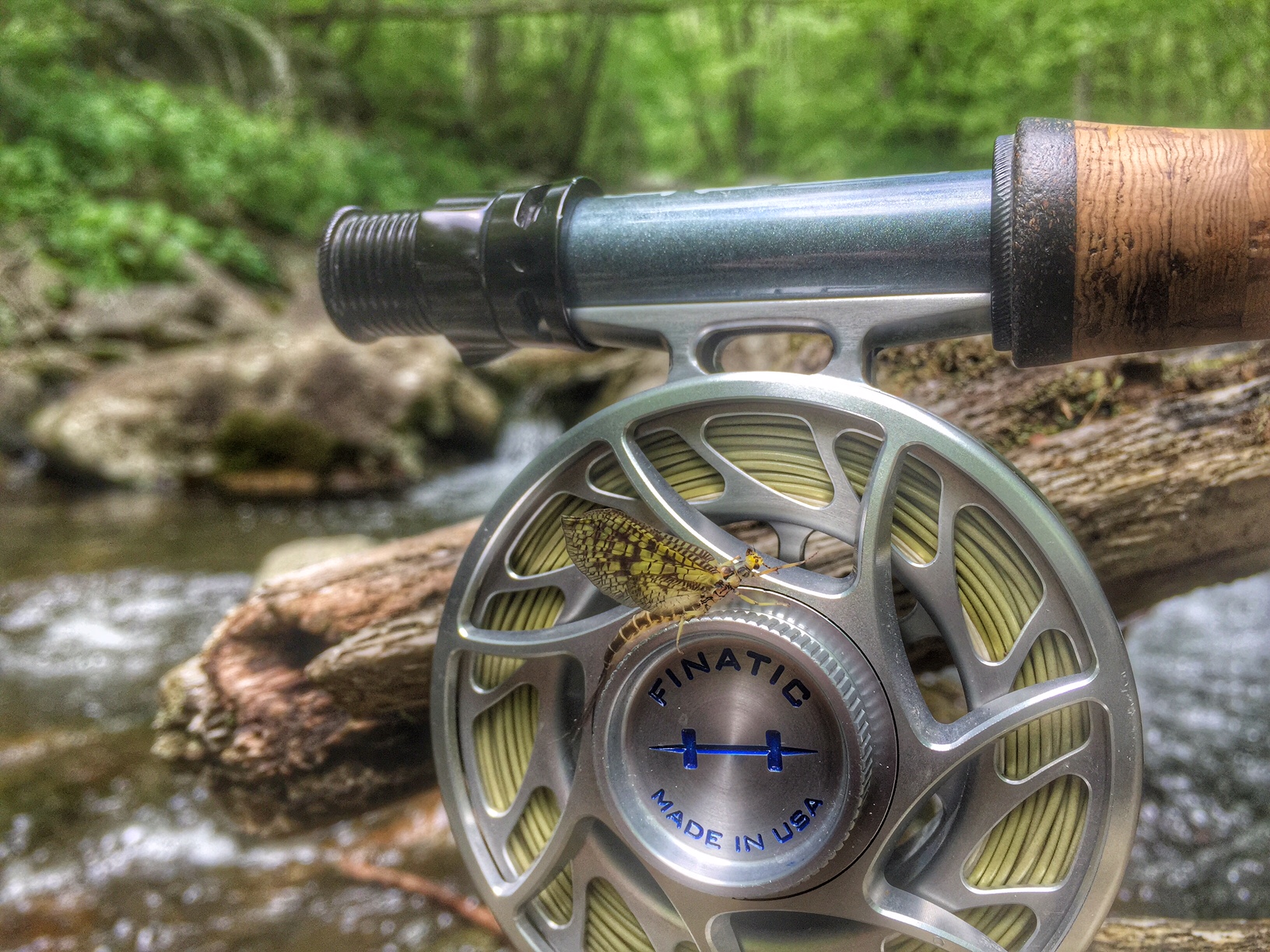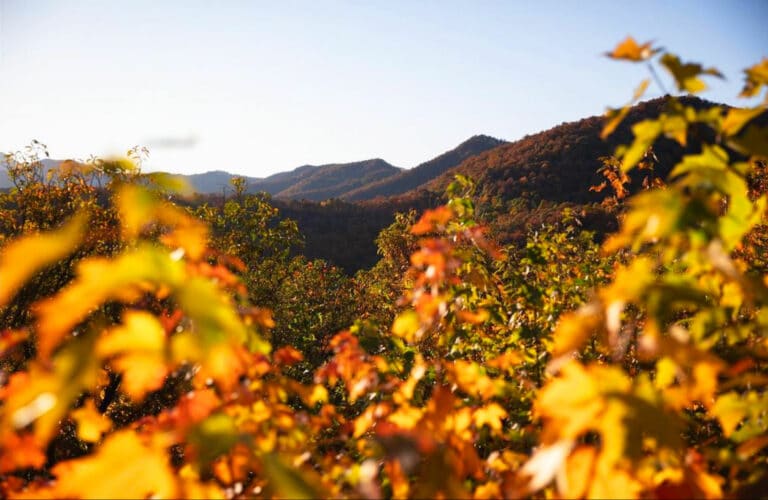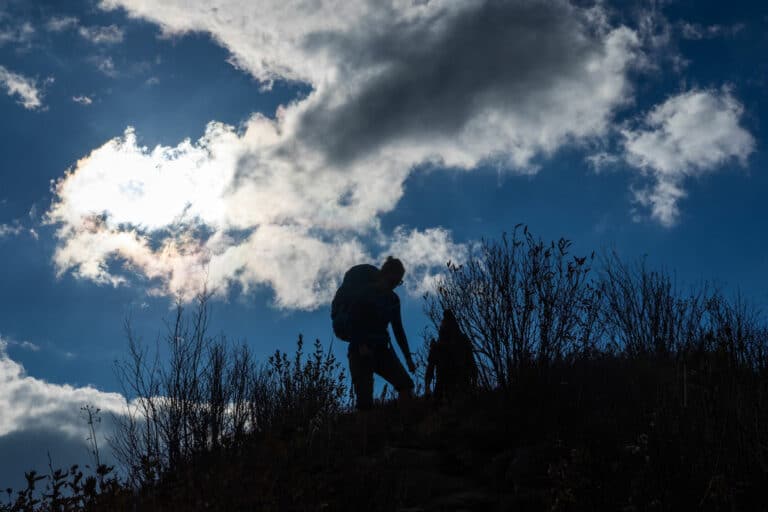Despite the recent resurgence of winter weather in many parts of the Blue Ridge, Spring is just around the corner. With the Spring Equinox bringing the first official day of the season this coming Monday, March 20, we reached out to a few of our favorite local guides for some tips, tricks, and go-to rivers for early Spring fly fishing.
Colby Trow, Mossy Creek Fly Fishing, Virginia
BRO: What are your go-to rivers for early Spring fly fishing?
CT: The James and Shenandoah Rivers would be our go-to rivers for early spring fishing. Pre-spawn smallmouth fishing in late March and early April can be incredible. We aren’t out looking for huge numbers of fish this time of year but we are looking to hook into a few of the biggest. Females generally have winter weight, plus full egg mass making them huge this time of year. These fish stage in very predictable spots in early Spring and anglers that know where the fish are can have some of their best fishing days of the year.
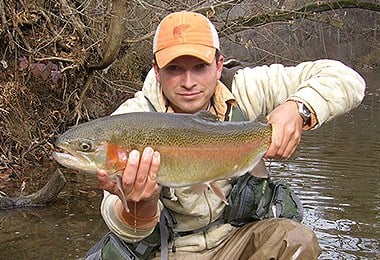
BRO: Any particular fly patterns you would recommend once Spring has sprung?
CT: Flies for big early Spring smallmouth are chosen depending on the water levels and clarity. Smallmouth are usually pretty aggressive this time of year eating large baitfish and crayfish.
Clawdads in size 1/0 and 2 in black, black/blue, dark olive, brown, or chartreuse would be one of our favorites. CK baitfish in size 1/0 and 1, size 2/0 half and halfs, and size 2 crittermites would round out our selection. Choose the largest, heaviest flies in dark colors for high water or high and dirty water.
In low clear water, we use the same patterns with lighter eyes or in smaller sizes so they don’t grab bottom. Baitfish patterns fished with aggressive twitches will also trigger strikes if water levels are low, and you are dealing with clear conditions.
BRO: What are the challenges that early Spring fly fishing presents? How do you overcome them?
CT: The biggest challenge to Spring fishing in general is the weather. Wind and rain can take peak season and make it brutal or even non-existent. Last year we entered March and April with extremely low water levels. This made for difficult fishing conditions for trout but made finding big smallmouth on the rivers very easy.
Nathan Capron, Hunter Banks Fly Fishing, North Carolina
BRO: How does trout behavior change during the early spring months, and how should anglers adjust?
NC: While average water temperatures warm during the transition from winter to spring, trout behavior shifts as they focus on feeding due to their rising metabolism. This happens to coincide with the first mayfly and caddis hatches of the season, which give the fish even more reason to feed more aggressively.
Expect to see Blue Quills, Quill Gordons, March Browns, a several other mayflies to emerge. The arrival of these hatches gives the opportunity to fish dry flies to fish “looking up” to the surface for adult insects.The shallow calm water typically found at the tail of pools becomes a key area in rivers to find feeding fish, rather than the deep holding water typically used by the fish in the winter.
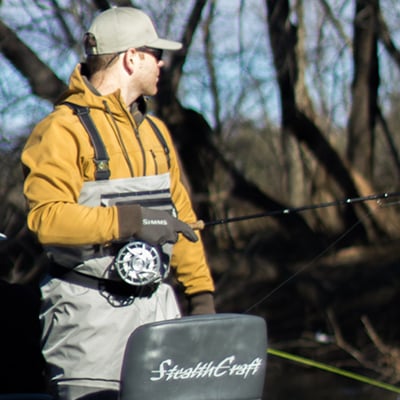
BRO: What’s your favorite or go-to river(s) for early Spring fly fishing?
NC: The Shelton Laurel & Big Laurel Rivers near Hot Springs, North Carolina are great options for Spring fly fishing due to good hatches, easy access, and consistent water levels.
The Tuckaseegee River near Cullowhee is also a great Spring fly fishing option with caddis hatches that can motivate fish from the depths of this wide, western-like river.
BRO: Any particular bugs or fly patterns you would recommend once Spring has sprung?
NC: Fishing dry flies to rising fish is the most popular fly fishing technique for trout, and Spring is the best time for this in Western North Carolina. Specific patterns to match include the Blue Winged Olive, Blue Quill, Hendrickson, March Brown, and Light Cahill mayflies.
These are all great flies to have in your arsenal along with an assortment of black and brown caddis patterns for the Spring and even Summer season. Old favorites like a Parachute Adams or Quill Gordon dry flies are also productive, despite not matching a specific insect.
BRO: Are there any challenges that early Spring fly fishing presents? How do you overcome them?
NC: Picking the right portion of the day to fish can be a challenge in the Spring. With cooler temperatures in the morning and evening, anglers will typically find the best fishing to be centered around the middle of the day.
Focusing on the right water for hatching insects is also a key to success. Fish the deep slower pools of a river in the morning and transition to the riffles, runs, and tails of pools in the afternoon when the water temperature has risen to cause more hatching insect activity.
Another common issue for anglers is the faster river flow and higher water levels that we typically experience in the Spring. Using longer leaders, heavier flies, and split shot to ensure that sub-surface nymph patterns make their way down to fish is critical for success, especially when the fish are not interested in surface dry fly patterns.
Josh Garris, Curtis Wright Outfitters, North Carolina
BRO: How does trout behavior change during the early spring months, and how should anglers adjust?
JG: In a typical year the Spring water temperatures can fluctuate greatly due to the outside temperature, along with any precipitation that falls or melts. Becasue fish are cold blooded, they are higly in tune with these changes. The cooler the water, the more lethargic the fish become. The insects that fish feed on also base their hatching on water temperature. All of this being said, look for the warmer parts of the day to fish. This is when the fish will be most active as well as the insects.

BRO: How do you overcome the challenges of early Spring fishing?
JG: Early spring is when we are starting to see a bit more consistent rains adding more water to the rivers, and a lot of the days dropping water temperatures as well. This can cause trout to hug the bottom of river behind boulders or log jams to stay out of the current in order to conserve energy.
They will, however, still need to feed. This is where some folks find difficulty in spring fishing. There are several techniques and even different equipment that can help put the odds back in your favor. One of the most important things to have in these situations is a split shot. Getting your flies down to where the fish are is the most important piece in fishing high water in spring. I recommend changing the depth of your flies (adding shot) at least 3 times before changing flies. You might have just what they want, but if they can’t see it, it won’t matter!
BRO: What are the big Spring hatches in your neck of the woods? When should anglers looking to take advantage be out on the water?
JG: The big Spring hatches for our area can be slightly unpredictable and often vary from river to river. With the warm winter we’ve had in Western North Carolina, we are already seeing some of our river insects hatch ahead of schedule.
For example, the Blue Quills, Quill Gordons, and Hendricksons made their first appearances weeks ago when they typically hang closer to the middle or end of March. If our warmer temperatures continue we should expect other insects to follow in suite. Hendrickson’s, March Browns, Light Cahills, and Sulphurs are usually due late April and early May, but we expect to see them sooner this year. The Sulphurs and Yellow Sally (small yellow Stone’s) are typically the most abundant bug in our area, but the largest, most famous, and definitely the most elusive is the Green Drake hatch, whcih typically happens towards the end of May. As we move more towards the middle/end of spring the mix on the river will become more varied.
Carson Oldham, Albemarle Angler, Virginia
BRO: How does trout behavior change during the early Spring months, and how should anglers adjust?
CO: Trout are a cold water species. However, if water temps get to cold they do slow down. In Spring, as water temps and levels start to rise, more and larger insects start to hatch. In Spring the fish feel safer due to higher water levels, so they are not as spooky and will be looking up for dry flies. In Spring, angler should fish larger dry flies.
BRO: What’s your go-to rivers for early Spring fly fishing?
CO: All of Virginia’s rivers fish great. Everything from the Jackson river, all the great brook trout streams, and even the James and Shenandoah rivers will start to fish great for smallmouth bass.

Matt Canter, Brookings Anglers, North Carolina
BRO: How does trout behavior change during the early Spring months, and how should anglers adjust?
MC: Springtime for trout is very similar to springtime for us. We have all been cooped up all winter, and now its time time get out and play! Because food sources have been scarce all winter for the trout, they are always happy when warmer weather arrives. This doesn’t mean the fish are all going to eat whatever you show them though. Spring in the Southeast means the most variety of bug hatches we have all year. There is plenty of food around during peak times of the day, so pay attention to all of the signs and try to imitate what is on the menu at that particular time.
BRO: What’s your go-to river for early Spring fly fishing?
MC: I don’t necessarily have a favorite river to fish in early spring, but I do have a favorite category of river, and that would be mid-sized rivers. In my experience you can roughly determine where the best place to fish is by two categories.: Season and size.

Here in the Southeast, we don’t have to deal with extreme cold very often. In fact, the more determinant factor when choosing a place to fish is heat. When it’s hot, it’s important to find cold water, and when it’s really cold the trout will be eating better in more moderate water temperatures.Typically your smallest trout streams will be highest on the mountain, and closest to the spring heads. The small streams don’t get a lot of direct sun either, because of the canopy of the trees over them. These factors keep the small stream’s water temperatures fairly cool. These small streams fish well all the way through summer.
Conversely, your big rivers are wide, meaning they receive lots of direct sunlight and they are also typically lower in elevation, which amounts to warmer climate. These factors equate to warmer water temperatures than the small streams and will produce happier feeding fish in the dead of winter.
A happy medium are the mid sized streams. These streams fish best during Spring and Fall. They have a good balance of moderate water temperatures, along with better bug life than your high elevation creeks. Good examples of mid-sized rivers include in our area are the Chattooga, North and East Fork of the French Broad, Upper Nantahala, and Oconaluftee Rivers. When heading to fish a stream in this category especially in Spring, don’t leave your dry fly box at home!
BRO: What are the big spring hatches in your neck of the woods?
MC: Dark Winter Stones, Black Caddis, Blue Quills, Quill Gordons, Blue Wing Olives, March Browns, Midges and Tan Caddis are some of the major hatches in Springtime here in the Southeast.
More from the Fridays on the Fly Blog:
